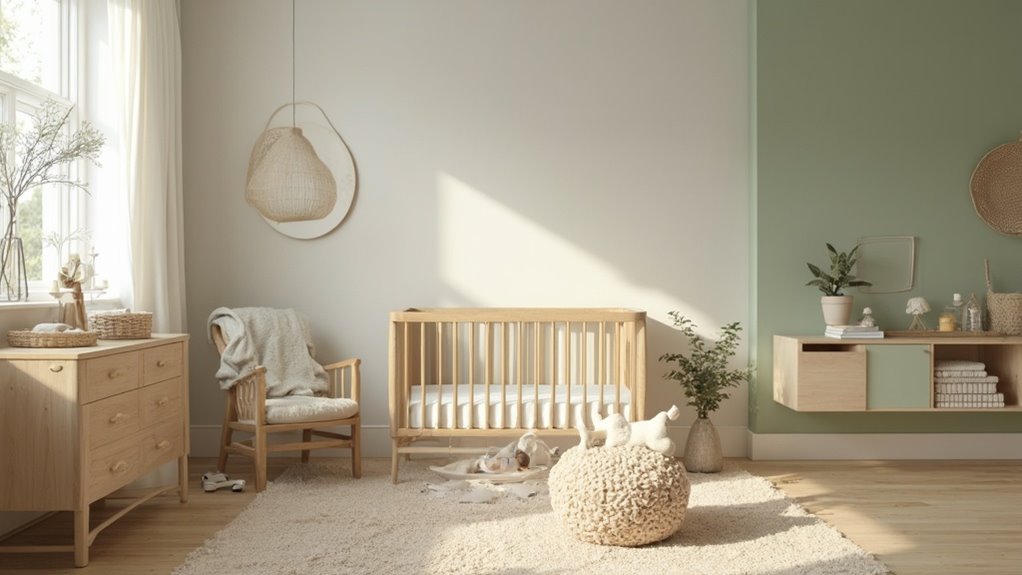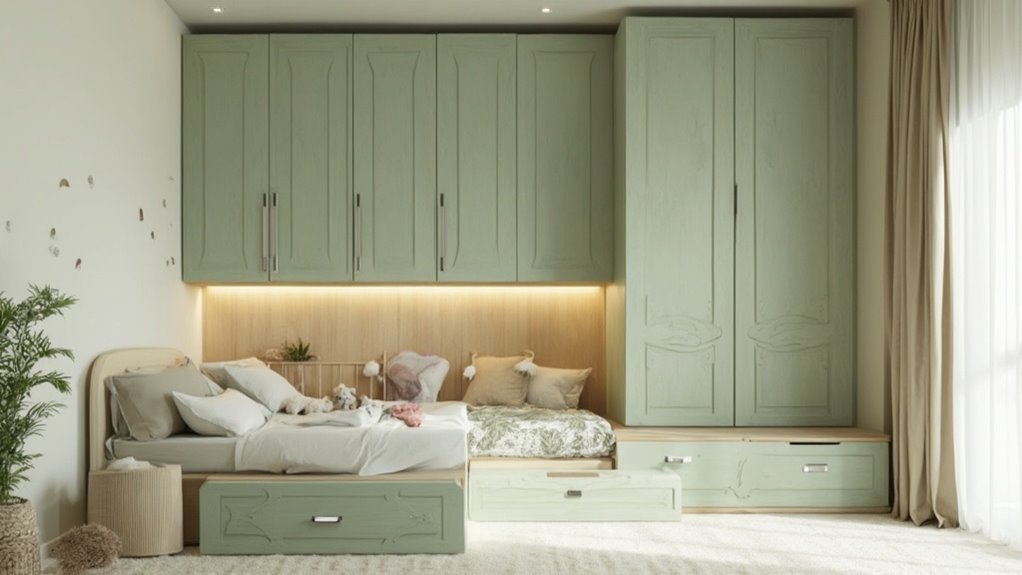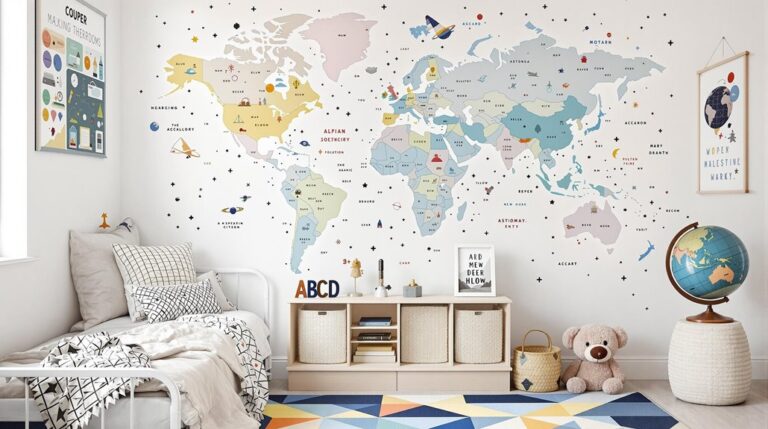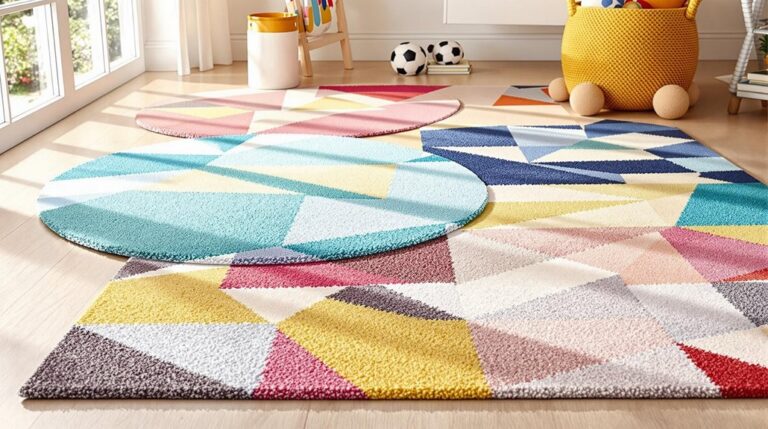Design a gender-neutral children's room by embracing a versatile neutral palette of soft grays, whites, and earth tones that create a calming, adaptable environment. Select universal themes like nature adventures or science exploration that spark creativity beyond traditional stereotypes. Choose modular, convertible furniture in natural finishes that grow with your child, and incorporate smart storage solutions that maximize space and organization. Layer textures through diverse textiles and patterns, creating sensory-rich experiences. Personalize the space with adjustable lighting zones and involve your child in design choices, transforming their room into a dynamic learning sanctuary that celebrates individuality. Intrigued? There's more magic waiting to unfold.
Briefly keys
- Choose a neutral color palette featuring soft earth tones, muted grays, and pastel shades that create a calming environment without reinforcing traditional gender stereotypes.
- Incorporate versatile furniture with modular designs that can adapt to changing developmental stages, ensuring long-term functionality and flexibility for growing children.
- Select universal themes like nature adventures or science exploration that stimulate creativity and curiosity beyond gender-specific design constraints.
- Layer textures and patterns strategically, using diverse textiles and complementary materials that create sensory-rich experiences without gender-coded visual elements.
- Design personalized spaces with adjustable lighting, multi-purpose storage solutions, and organizational systems that support individual preferences and developmental needs.
Start With a Neutral Palette

Designing a gender-neutral children's room requires thoughtful color selection that creates a welcoming and adaptable environment. Contemporary design trends emphasize color psychology that transcends traditional gender stereotypes, focusing instead on creating spaces that nurture creativity and comfort. Earth tones like sandy brown, ocean teal, and soft greens offer a sophisticated palette that feels natural and calming. Color harmony can significantly influence a child's emotional and cognitive development, making the room's design more than just aesthetic.
Neutral colors provide remarkable versatility, allowing the room to evolve alongside the child's developing personality. Soft grays, whites, and muted blues form an elegant foundation that can be easily transformed with accent pieces and decor. These understated hues create a serene backdrop that stimulates imagination without overwhelming sensory experiences.
By carefully selecting a neutral color scheme, parents can craft a timeless space that feels both modern and intimate. Warm neutrals like camel and beige introduce a cozy aesthetic, while lighter shades maintain an airy, expansive feel. The strategic use of complementary tones and textures adds depth and visual interest, ensuring the room feels dynamic yet harmonious.
Ultimately, a well-designed gender-neutral room celebrates individual expression, moving beyond traditional color constraints and embracing a more inclusive approach to children's spaces.
Choose Universal Room Themes
Every thoughtful children's room requires a universal theme that transcends traditional gender boundaries, creating a stimulating and inclusive environment.
By exploring diverse design concepts, parents can craft spaces that spark creativity and curiosity without relying on stereotypical color schemes or predictable motifs.
Nature adventure themes offer an expansive canvas, incorporating earthy tones, vintage travel accessories, and elements that celebrate exploration. Natural color palettes provide a foundational approach to creating welcoming, unbiased spaces.
Picture walls adorned with maps and globes, complemented by woven baskets and warm green hues that invite young minds to dream of safari expeditions and maritime journeys.
Science education themes provide another compelling approach, transforming rooms into intellectual playgrounds.
Neutral greys and whites serve as sophisticated backdrops for star charts, periodic table artwork, and scientific instruments that transform learning into an immersive experience.
Geometric designs add visual complexity, utilizing bold prints and citrus-infused color palettes that energize the space.
Retro whimsy introduces playful dimensions, blending vintage-inspired furnishings with modern sensibilities.
Cloud-shaped beds, magical lighting systems, and rainbow color spectrums create environments that are simultaneously nostalgic and forward-thinking, ensuring children's spaces remain dynamic and inspiring.
Select Versatile Furniture Pieces

The cornerstone of a gender-neutral children's room lies in selecting versatile furniture pieces that adapt seamlessly to evolving needs and preferences. Convertible beds become transformative investments, morphing from toddler-sized sanctuaries to sophisticated teen retreats with minimal effort. Envision a solid wood bed that shifts effortlessly from a cozy childhood haven to a sleek twin configuration, its neutral finish ensuring timeless appeal. Twin XL beds provide an extra four inches of length, accommodating growing children's comfort needs and supporting future design transformations.
Modular systems offer unparalleled flexibility, allowing parents to reconfigure spaces as children grow. A desk that doubles as storage, a bed with built-in drawers, or loft designs that maximize vertical space epitomize smart, adaptable furniture choices. These pieces aren't just functional—they're strategic long-term investments that grow alongside your child's changing interests and spatial requirements.
Consider furniture with interchangeable components: headboards that can be swapped, beds that convert into bunk arrangements, and storage solutions that encourage independence.
White, natural wood, or chestnut finishes maintain a neutral palette, ensuring the room remains a blank canvas for creativity. By prioritizing versatility, you create a dynamic environment that nurtures creativity, accommodates evolving needs, and transcends traditional gender-specific design constraints.
Layer Textures and Patterns
Texture transforms a gender-neutral children's room from merely functional to deeply engaging, creating sensory experiences that invite exploration and comfort. By employing strategic layering techniques, designers can craft spaces that stimulate curiosity and provide tactile delight for children.
Smart pattern combinations breathe life into neutral rooms, allowing creativity to flourish without traditional gender constraints. Mixing stripes, polka dots, and chevron patterns creates visual intrigue while maintaining a balanced aesthetic.
Consider combining rugs with different textures—perhaps a plush wool rug atop a woven jute base—to add dimensionality and depth. Neutral color palettes provide a versatile foundation for these textural explorations.
Textile diversity becomes your secret weapon. Incorporate soft wool blankets, velvet cushions, and cotton throws to create a rich sensory landscape. Woven baskets, macramé wall hangings, and abstract artwork further enhance textural complexity.
Natural elements like wooden prints or stone-inspired accessories can introduce organic textures that ground the room's design.
Lighting plays an essential role in texture revelation. Pendant lights with feathered or intricate designs, string lights casting soft shadows, and uniquely textured floor lamps contribute subtle yet impactful dimensional qualities that transform a simple space into a wonderland of tactile exploration.
Create Personalized Lighting Zones

Children's individual lighting needs transform a room from generic to personalized, creating spaces that adapt to their unique preferences and activities. By strategically designing lighting zones, parents can craft an environment that supports each child's distinct interests and daily rhythms.
Reading nooks become magical sanctuaries when illuminated with soft, focused table lamps that invite exploration and imagination. A carefully positioned desk lamp can turn a study area into an inviting homework zone, encouraging concentration and creativity.
Floor lamps strategically placed near play areas create a playful ambiance that makes spaces feel both functional and whimsical.
Personalization is key: Allow children to select lamp styles or shades that reflect their personality, transforming lighting from a mere utility to an exciting design element.
Consider creating individual reading zones with adjustable lighting that can grow with the child, accommodating changing needs and interests.
Night lights offer gentle illumination, providing comfort and safety while creating a soothing bedtime atmosphere. Neutral color palettes can help create a calming environment that adapts to evolving design preferences.
Maximize Smart Storage Solutions
Within gender-neutral children's rooms, smart storage solutions become pivotal in creating organized, adaptable spaces that grow alongside developing personalities. Space saving techniques transform ordinary rooms into dynamic environments where functionality meets creativity.
Vertical storage emerges as a game-changing strategy, utilizing wall space to keep floors clear and rooms feeling expansive. Floating shelves can display cherished books and delicate items, while over-the-door organizers and wall-mounted hooks provide ingenious homes for accessories and outerwear. Reduced anxiety levels can be achieved through strategic organizational approaches.
These organization strategies not only maximize square footage but also create visual interest and teach children valuable tidying skills.
Multi-purpose furniture becomes a secret weapon in smart storage. Toy chests with lift-top lids, beds with built-in drawers, and pegboards with interchangeable hooks offer flexible solutions that adapt as children grow.
Under-bed storage containers and trundle beds create additional hidden spaces for seasonal clothing, extra bedding, and treasured collections.
Closet organization represents another critical element, with customizable shelving, color-coded bins, and strategic hanging systems ensuring every item has a designated place.
The result? A clutter-free, harmonious space that supports a child's imagination and independence.
Involve Children in Design

A collaborative design approach transforms a child's bedroom from a mere living space into a personalized sanctuary that nurtures creativity and self-expression. By involving children in design choices, parents can create a room that reflects their child's unique personality and interests.
Color selection becomes an exciting adventure when children are part of the process. Guiding them toward neutral palettes with playful variations allows for personal input while maintaining design integrity. Whether choosing soft greens, muted grays, or pastel tones, children can feel empowered by contributing to the room's aesthetic.
Furniture selection similarly benefits from child preferences. Low-height beds that encourage independence, multifunctional desks with storage, and accessible layouts give children a sense of ownership. Involving them in selecting bedding, artwork, and decorative elements further personalizes the space.
The key is striking a balance between adult guidance and child autonomy. By creating an environment that respects their emerging identity, parents can design a room that feels both safe and stimulating. Cognitive development strategies demonstrate that personalized spaces significantly enhance a child's learning and emotional growth.
Educational elements like world maps, chalkboard walls, and meaningful artwork transform the space into a dynamic canvas of self-discovery.
Balance Comfort and Functionality
Comfort and functionality intertwine as essential design principles when creating a gender-neutral children's room. By prioritizing safety considerations and ergonomic design, parents can craft a space that nurtures a child's growth and imagination while remaining adaptable and practical.
Versatile furniture plays an important role in achieving this balance. Adjustable desks that accommodate a growing child's height, bunk beds with integrated storage, and modular shelving units provide dynamic solutions that evolve with the child's changing needs. Multi-functional pieces like beds with built-in drawers maximize space efficiency without sacrificing aesthetic appeal.
Zoning the room strategically helps create distinct areas for different activities, ensuring each space feels purposeful and comfortable. A reading nook with soft lighting, a play area with ample floor space, and a sleeping zone with ergonomic considerations can coexist harmoniously. Developmental stage considerations are crucial when designing spaces that adapt to a child's evolving needs and interests.
Incorporating storage solutions within each zone maintains organization and reduces visual clutter.
Texture and neutral color palettes further enhance the room's comfort, creating a calming environment that stimulates creativity while remaining visually engaging.
People are Asking
How Much Will It Cost to Design a Gender-Neutral Children's Room?
The cost of designing a gender-neutral children's room ranges from $1,500 to $5,000, depending on budget considerations like furniture quality, decor choices, and cost breakdown for essential items such as crib, storage, and accessories.
Can Siblings With Different Ages Share the Same Bedroom Design?
Siblings with different ages can successfully share a bedroom by creating zoned areas, adapting furniture for versatility, and designing shared spaces that accommodate their unique developmental needs and individual preferences.
What if My Children Have Completely Different Style Preferences?
Style compromise involves collaborative design choices where each child selects personalized accents within a neutral base palette. Preference negotiation guarantees individual expression while maintaining a cohesive, harmonious shared bedroom environment.
How Often Should I Update or Refresh the Room's Design?
Update the room's design every 2-3 years, focusing on seasonal updates and adapting to your child's evolving interests, developmental stages, and functional needs while maintaining a flexible, timeless aesthetic.
Are Gender-Neutral Rooms Suitable for Long-Term Child Development?
Can children genuinely thrive in adaptable spaces? Gender-neutral rooms support thorough child development by offering design flexibility, enabling personalized exploration and reducing restrictive stereotypes that might limit individual growth and potential.
Wrapping up
Designing a gender-neutral children's room transcends traditional aesthetic boundaries, creating a dynamic, adaptable space that nurtures individual creativity and development. By prioritizing versatile design elements, functional considerations, and personal expression, caregivers can craft an environment that celebrates uniqueness while providing comfort and inspiration. The ultimate goal remains supporting a child's imagination and growth through thoughtful, inclusive design strategies.




